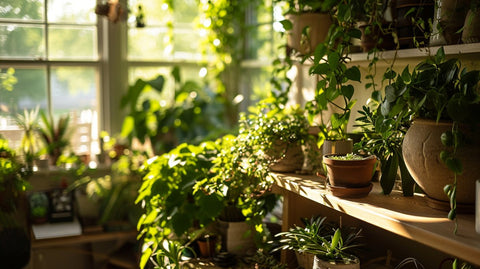How To Grow And Care For Podocarpus

Podocarpus, often referred to as "Buddhist Pine" or "Fern Pine," stands as a testament to both beauty and resilience in the plant world. These evergreen conifers, renowned for their ease of care and versatile nature, make a significant impact in landscaping and as ornamental plants. In this comprehensive guide, we delve deep into the world of Podocarpus, providing you with all you need to know about growing and caring for these magnificent plants.
Plant Attributes
The Podocarpus genus, belonging to the family Podocarpaceae, is highly valued for its elegant form, vibrant green foliage, and adaptability. They can vary significantly in size – from small shrubs to towering trees – making them suitable for a diverse range of gardening and landscaping needs.
One of the most popular selections in our collection is the Podocarpus macrophyllus, available at Plantology USA. Known for its straight, upright growth and lush, fern-like foliage, this species is a favorite among both beginners and seasoned gardeners.
Podocarpus Care
To ensure your Podocarpus thrives, understanding its basic care requirements is crucial. These plants are not overly demanding, but they do appreciate attention to detail in certain areas.
Light
Podocarpus plants prefer bright, indirect light but can also adapt to lower light conditions. Avoid direct sunlight, especially during the harsh midday hours, as it can scorch the leaves.
Soil
A well-draining soil mix is vital for Podocarpus. These plants do not like to sit in waterlogged soil, so ensure adequate drainage in the pot or ground where they are planted.
Water
Regular watering is essential, especially during the growing season. Allow the top layer of soil to dry out slightly between waterings. Overwatering can lead to root rot, a common issue with these plants.
Temperature and Humidity
Podocarpus plants are quite adaptable to different temperature ranges but prefer a consistent environment. They thrive in moderate to high humidity levels.
Fertilizer
Use a balanced, slow-release fertilizer during the growing season to support healthy growth. Over-fertilizing can harm the plant, so follow the recommended dosage and frequency.
| Specification | Detail |
|---|---|
| Plant Name | Podocarpus (Podocarpus macrophyllus) |
| Mature Height | 10-12 feet |
| Mature Width | 5-6 feet |
| Spacing | 3-4 feet apart |
| Sunlight | Full to Partial Sun |
| Temperature Tolerance | 30-80°F |
| Watering Needs | Moderate (Once a week) |
| Growth Rate | 10 inches/year |
| Difficulty Level | Easy |
| Grows Well Indoors | Yes, with indirect sunlight |
| Flowering Time | Spring to Early Summer |
| Origin | Native to South America |
Types of Podocarpus
In addition to the popular Podocarpus macrophyllus, there are other notable varieties worth exploring:
-
Podocarpus Maki (Podocarpus Macrophyllus 'Maki'): A more compact variant, ideal for smaller spaces or as a hedge plant. Learn more.

-
Podocarpus Pringles (Podocarpus pringle): Known for its dense, upright growth, making it an excellent choice for topiaries. Discover Podocarpus Pringles.

-
Plum Pine Weeping (Podocarpus Gracilior): With a graceful, weeping form, this variety adds a unique touch to any garden. Find out more about Plum Pine Weeping.

Propagating Podocarpus
Propagation of Podocarpus can be achieved through cuttings or seeds. For cuttings, select a healthy, non-flowering shoot and root it in a well-draining soil mix. Seed propagation, while slower, can be rewarding and allows for the cultivation of new varieties.
Potting and Repotting Podocarpus
Choosing the right pot and knowing when to repot are essential for the health of your Podocarpus. Repotting is typically needed every 2-3 years to provide fresh soil and additional space for growing roots.
Overwintering
Overwintering is a crucial aspect of Podocarpus care, especially in regions where temperatures drop significantly. Here are some tips to ensure your Podocarpus stays healthy during the colder months:
- Indoor Overwintering: If you have potted Podocarpus, consider moving them indoors to a well-lit area that maintains a stable temperature.
- Outdoor Overwintering: For outdoor plants, mulching around the base can help retain soil warmth and moisture. Also, consider using burlap wraps or frost cloths to protect them from harsh winds and frost.
- Watering Adjustments: Reduce watering in winter as the plant's growth slows down. Overwatering during this dormant period can lead to root rot.
Common Problems With Podocarpus
Even with proper care, Podocarpus can encounter a few problems. Being aware of these issues and knowing how to tackle them can keep your plants healthy:
- Pest Infestations: Keep an eye out for pests like spider mites and scale insects. Regular inspection and prompt treatment with appropriate insecticides or natural remedies can control these pests.
- Fungal Diseases: Root rot and needle blight are common fungal issues, often due to overwatering or poor drainage. Ensure proper watering habits and soil conditions to prevent these problems.
- Nutrient Deficiencies: Yellowing leaves or stunted growth may indicate a lack of nutrients. Regular fertilization and soil testing can help maintain the necessary nutrient levels.
Conclusion
Podocarpus plants, with their diverse varieties and manageable care requirements, are an excellent choice for gardeners and plant enthusiasts. Whether you're looking for a stately Podocarpus macrophyllus or a unique Plum Pine Weeping, these plants add elegance and greenery to any setting.
Remember, the key to thriving Podocarpus plants lies in understanding their needs – the right balance of light, water, soil, and nutrients. With proper care, these plants can be a long-lasting, beautiful addition to your indoor or outdoor spaces.
Visit Plantology USA for a variety of Podocarpus plants, including our most popular selection, the Podocarpus macrophyllus, and explore the wonders of these evergreen beauties. Happy gardening!






























Comments (0)
There are no comments for this article. Be the first one to leave a message!